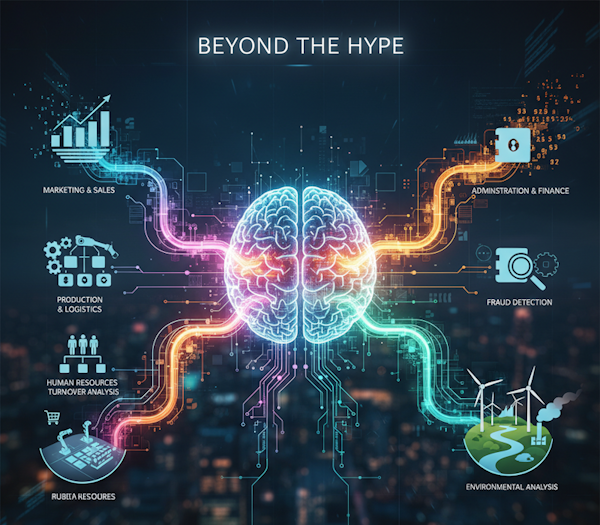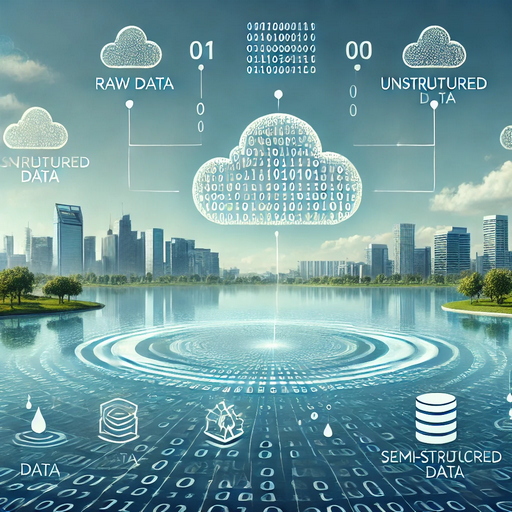Machine Learning: 5 Practical Applications for Your Management System
How an algorithm can replace 40 years of trial and error, and why this is not an exceptional story, but the new normal for companies.
In a week, I will walk into a classroom to show environmental analysis experts how Machine Learning (ML) can be the most methodical and infallible colleague they have ever had. Their playing field is the environmental data of pharmaceutical and electronics companies; my task is to provide them with a very powerful magnifying glass to read that data.

The reflection I bring to the classroom is always the same: we are inundated with the buzz around Large Language Models (LLMs), as if artificial intelligence were reduced to knowing how to chat. But while all the attention is there, another type of intelligence – silent, analytical, and devastatingly effective – continues to solve real business problems. This intelligence is classic Machine Learning, the art of making a machine learn from data.
Not Conversation, But Prediction: The True Purpose of ML
It is crucial to make a distinction.
- Large Language Models (LLMs) are highly skilled in language. They generate text, summarize, respond. They are a tool of interface, of dialogue.
- Machine Learning is a tool of analysis and prediction. Its purpose is to find hidden patterns and causal relationships in mountains of data to:
- Predict a future event (a failure, a sale, a pollution peak).
- Classify (a fraudulent transaction, a manufacturing defect).
- Optimize complex processes (logistics, plant parameters).
ML does not talk, it acts. And the action translates into savings, efficiency, and competitive advantage.
The Course: Why the Environment is a Perfect Playground for ML
Environmental data is the ideal example of a complex problem that ML can tame. It is multivariate (emissions, water, energy, chemical parameters) and interconnected. The human eye can grasp simple correlations; ML finds non-linear and counterintuitive relationships.
Here’s what can be done:
- Predictive Maintenance: Predicting a failure in a treatment plant by analyzing sensor data, to intervene only when necessary.
- Breach Prediction: Understanding, by cross-referencing production and weather data, when an exceedance of emission limits is most likely, in order to proactively adjust processes.
- Energy Optimization: Finding the perfect combination of operational parameters that minimizes energy consumption while maintaining maximum effectiveness.
These are not academic experiments. They are projects with tangible and immediate ROI. They transform ML from a cost into an investment.
5 Practical ML Applications for Your Management System
But the true revolution of Machine Learning happens when its predictive logic integrates into the company’s nervous system: the management software or ERP. These systems, which already contain the history of every business movement - purchases, sales, production, warehouse - are gold mines waiting to be exploited.
Here’s how ML can transform an ERP from a static archive into a strategic consultant:
-
Demand Forecasting and Warehouse Optimization: ML can analyze historical sales series, integrate them with external data (economic trends, weather forecasts, social media trends) and predict future demand for every single SKU with an accuracy impossible for traditional methods. The management system can thus suggest optimal purchase orders, not based on simple monthly averages, but on sophisticated predictive models. This means working capital not blocked in useless inventory and no lost sales due to stockouts.
-
Integrated Predictive Maintenance: For a manufacturing company, the maintenance module of the ERP no longer has to manage only scheduled interventions or breakdowns. By connecting machine sensor data (vibrations, temperature) to the ERP, an ML model can predict failure and automatically generate a work order for maintenance, order the necessary spare parts, and notify the technician. The ERP becomes the central brain of a factory that prevents, not just reacts.
-
Late Payment Prevention and Credit Optimization: By analyzing customer payment behavior, their purchases, and perhaps external data on sector crises, a model can assign a real-time risk score to every invoice issued. The ERP’s credit management system can then alert the salesperson to follow up with particular attention on an at-risk customer, suggesting proactively offering advance or installment payments. You move from managing late payments to preventing them.
-
Fight Against Fraud and Anomalies: An algorithm can monitor in real time all financial and purchasing transactions, learning the “normal behavior” of the company. When it detects an anomaly (e.g., a purchase order to an unknown supplier, an unusually high expense reimbursement), it immediately alerts the controller. ML becomes the ever-vigilant sentinel over process correctness.
-
Dynamic Price and Promotion Optimization: Machine Learning analyzes in real time demand elasticity, competitor prices, inventory availability, and purchasing behaviors to calculate the optimal price for each product at any given moment. The system can suggest targeted discounts, promotional bundles, and dynamic pricing strategies that maximize margins without sacrificing sales volume. Revenues are optimized scientifically and automatically, adapting to market conditions in real time.

A Real Case: 40 Years of Try & Error vs. a Predictive Model
I happened to work with a metalworking company in northeastern Italy, an excellence that produces precision components and invoices hundreds of millions of euros every year. For a particular machining process, they possessed a handed-down knowledge heritage: a long and cumbersome process of adjustments “by feel,” based on experience and a long sequence of trial and error for every new batch of material. It worked, but it was slow, costly, and dependent on the human factor.
The problem was not a mysterious breakdown, but the inefficiency of an archaic decision-making process.
After interviewing all the people involved in the process, I understood what the problem to be solved was and how. We trained a Machine Learning model on historical production data: machine parameters, material types, temperatures, test results. In a short time, the model learned to accurately predict the optimal machine settings for that particular type of machining, directly from the characteristics of the input material.
The result? What was a handed-down art, made of tests and adjustments, became an exact and immediate science. They replaced 40 years of “let’s try and see” with an algorithm that provides the right answer on the first try (to be honest, the model had an accuracy close to 90%). They compressed setup time, reduced waste, and made the process independent of any single person. They, in practice, encoded their most valuable experience into software.
The Right Tool for the Right Job
Those who know me are aware that my job is not to promote a specific tool, but to solve problems. To do this, I choose what I believe is the technology most suited to the context. Currently, for rapid prototyping, exploratory data analysis, and teaching, Python with its libraries (scikit-learn, XGBoost) is indispensable for its flexibility and rich ecosystem. However, I see enormous value in bringing the power of ML to other production environments, perhaps more traditional ones. For this reason, I am writing a library for Delphi that implements fundamental algorithms like Decision Trees, Random Forest, and K-Nearest Neighbors (KNN). The idea is to natively integrate solid predictive capabilities into existing desktop enterprise applications, bringing ML closer to the point where the problem manifests itself, without technological dogmas.
LLM and ML: A Strategic Collaboration
LLMs are not the enemy but a fundamental ally. The real opportunity, however, lies in integrating them with analytical ML. Imagine a system where:
- A manager asks their ERP through a chatbot: “Why did the margin for product X drop in November?”
- The chatbot (LLM) queries the ML models that analyze production costs, volumes, and selling prices.
- The models provide the root cause (“increase in the cost of raw material Y not compensated by an adequate adjustment of the list price”).
- The LLM translates this technical analysis into a natural language response: “The margin dropped because the cost of component Y increased by 15% in November. I suggest reviewing the price list for future orders.”
The LLM acts as the spokesperson, the ML as the analyst. Together, they create a virtuous cycle of understanding that transforms a management system from a data archive into a strategic consultant.
Conclusion: A New Decision-Making Mindset
The story of the metalworking company is not exceptional. It is simply what happens when you replace a vague hypothesis with a data-driven prediction. The competitive gap is not created between those who have and those who do not have AI, but between those who decide based on intuition and those who decide based on statistical evidence.
Machine Learning is not a wizard that solves magical problems. It is a logical mechanism that solves logical problems, but at a speed and depth that the human intellect alone will never be able to match (the brain is far more powerful than any ML algorithm but is simply optimized to do other things). And its most powerful application is perhaps precisely that of making intelligent the systems we already use every day, from management software to production machines.
The final question, therefore, is not “Can I afford Machine Learning?”, but “Which of my daily decisions, currently entrusted to intuition or long and costly processes, could I entrust to a predictive analysis?”. The answer to this question is the first step towards a completely new way of doing business.
Comments
comments powered by Disqus